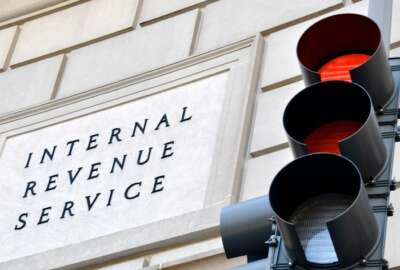

The Biden administration is setting a high bar for customer experience across government, but it’s the General Services Administration that’s laying the...
Best listening experience is on Chrome, Firefox or Safari. Subscribe to Federal Drive’s daily audio interviews on Apple Podcasts or PodcastOne.
The Biden administration is setting a high bar for customer experience across government, but it’s the General Services Administration that’s laying the foundation for those improvements.
GSA, under the administration’s executive order on improving customer experience, is looking to make digital services at other agencies secure and accessible through Login.gov, a shared service for online identity verification across the federal government.
GSA Administrator Robin Carnahan, in a recent interview, said Login.gov has about 40 million users right now across 27 agencies, and is looking to increase usage to 100 million users by the end of the year.
“We’ve got big aspirations there. My personal view is that this digital identity area is one that is in serious need of attention by the government,” Carnahan told Federal News Network.
Carnahan said that government-issued photo IDs, including driver’s licenses, have long been the “gold standard for identity.” But she said a digital equivalent of that gold standard has not yet come into focus.
“When it comes to digital identity, I think we need to equally let people have access to a digital identity from the government that is secure, that protects their privacy and that is accessible to everyone, so we want to be able to offer this,” she said.
Carnahan pointed to COVID-era fraud and inaccessibility of unemployment benefits earlier in the pandemic as reasons for prioritizing a secure digital identity for online services.
“We also saw that scammers took huge advantage of this, and that billions of dollars were lost, all because of this notion of getting a digital identity, and so we think it’s really important. We think it saves a lot of money for taxpayers, and it helps government deliver at people’s time of need,” she said.
The Biden administration’s customer experience executive order directs GSA to work with the Department of Veterans Affairs to make Login.gov the identity-verification foundation across all VA’s online services.
Carnahan said about 60,000 veterans currently use Login.gov as an identity proofing service, and that those numbers are going to increase.
The VA made progress on that goal this week, when it announced veterans can now use the same through Login.gov username and password to access VA.gov, My HealtheVet, and VA’s Health and Benefits mobile app.
VA Chief Technology Officer Charles Worthington said in a statement that the rollout of Login.gov at the agency will “streamline how users access government benefits and services.”
“As part of the department’s digital transformation efforts focused on continuous improvement, we’re embracing the innovative technology designed by Login.gov to provide our veterans a seamless sign-in experience to better serve, engage and enhance the customer experience,” Worthington said.
Dave Zvenyach, the director of GSA’s Technology Transformation Services, said Login.gov will provide a “secure and seamless digital experience for veterans and those supporting them.”
The service also allows veterans to use the same credentials to access services across multiple federal agencie, including the Office of Personnel Management and the Small Business Administration.
Carnahan said GSA is also “having lots of conversations with the IRS,” as it plans its own adoption of Login.gov as an identity verification service.
“Obviously this is one of the primary interactions people have with government every year, and we ought to make that seamless. We ought to do it in a way that protects the privacy and ensure security and make sure it’s accessible to everybody,” Carnahan said.
The IRS announced it would pivot to Login.gov after it launched a new identity verification process last year, which initially relied on facial recognition technology from ID.me. The process, however, received strong pushback from Congress and the public.
The administration tapped Carnahan to serve as one of three interagency leads on improving customer experience across government as part of the President’s Management Agenda.
Biden administration, under the PMA, is directing agencies to prioritize customer experience improvements around five cross-cutting priority “life experiences.”
These include helping individuals who are approaching retirement age, recovering from a disaster, or transitioning from active-duty military service.
GSA, as part of this interagency team, is focused on improving public-facing services at 35 agencies and programs designated as High-Impact Service Providers.
“We’re going in and having technology teams that focus on user experience and customer experience look at those journeys to see what that actual interaction is like, and how to streamline the process and make it easier,” Carnahan said. “Part of that’s about communicating in plain language. Part of it’s about how you design the websites. Part of it’s about how many steps there are in the process.”
The Biden administration’s executive order also directs GSA to make USA.gov a “digital front door” for individuals seeking federal services.
“A citizen shouldn’t have to try to figure out what agency to go to for some service and have to understand the structure of government. They ought to be able to go to usa.gov, talk about what their interests or need is, and then be directed to the right place,” Carnahan said.
The administration is focused on ensuring historically underserved communities have access to government services. To achieve that goal, Carnahan said agencies need a diverse range of experts at the table to create these services.
“We don’t pick our customers. It’s all Americans that we’re here to serve. The only way you can do that effectively, is if you have a cross-section of people in the room being talked to about how to make sure the services we’re providing are accessible to everyone,” Carnahan said.
GSA is also looking at ways to support the federal workforce as it looks to improve service to the public. Carnahan said the agency is looking at developing “easier on-ramps to be able to come work in government,” and helping agencies re-imagine their workspaces as part of its “Workplace 2030” initiative.
Through its Workplace 2030 initiative, GSA is also looking at offering federal employees a “home office in a box,” giving workers the option to furnish a home office with work gear needed for their jobs.
Carnahan said GSA is also looking to provide federal co-working spaces where federal employees can work out of the office.
“We’re talking a lot to our customers about what their needs are. But we know the future is going to look different than the past. And GSA is going to try to be on the front lines of serving our customers so they can better serve the public,” Carnahan said.
Copyright © 2025 Federal News Network. All rights reserved. This website is not intended for users located within the European Economic Area.
Jory Heckman is a reporter at Federal News Network covering U.S. Postal Service, IRS, big data and technology issues.
Follow @jheckmanWFED


